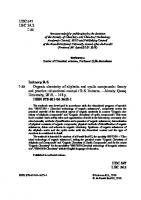Cyclic Sieving, Promotion, and Representation Theory
337 27 1MB
English Pages [91] Year 2008
1. Introduction p. 1
2. Tableaux and Representation Theory Background p. 10
3. Promotion on Standard Tableaux p. 26
4. A Construction of the Finite Dimensional
Irreducible GLk(C) Representations p. 42
5. Promotion on Column Strict Tableaux p. 55
6. Promotion on Column Strict Tableaux with Fixed Content p. 61
7. Dihedral Actions p. 68
8. Applications to Other Combinatorial Actions p. 76
9. Open Problems p. 81
10. Bibliography p. 83
Recommend Papers
File loading please wait...
Citation preview
Cyclic Sieving, Promotion, and Representation Theory
A DISSERTATION SUBMITTED TO THE FACULTY OF THE GRADUATE SCHOOL OF THE UNIVERSITY OF MINNESOTA BY
Brendon Patrick Rhoades
IN PARTIAL FUFILLMENT OF THE REQUIREMENTS FOR THE DEGREE OF DOCTOR OF PHILOSOPHY
Victor Reiner, Adviser
July 2008
UMI Number: 3321927 Copyright 2008 by Rhoades, Brendon Patrick
All rights reserved.
INFORMATION TO USERS
The quality of this reproduction is dependent upon the quality of the copy submitted. Broken or indistinct print, colored or poor quality illustrations and photographs, print bleed-through, substandard margins, and improper alignment can adversely affect reproduction. In the unlikely event that the author did not send a complete manuscript and there are missing pages, these will be noted. Also, if unauthorized copyright material had to be removed, a note will indicate the deletion.
®
UMI UMI Microform 3321927 Copyright 2008 by ProQuest LLC. All rights reserved. This microform edition is protected against unauthorized copying under Title 17, United States Code. ProQuest LLC 789 E. Eisenhower Parkway PO Box 1346 Ann Arbor, Ml 48106-1346
© Brendon Patrick Rhoades
2008
Acknowledgments I'd like to thank my two advisers Victor Reiner and Mark Skandera. Without their seemingly endless supply of advice, encouragement, and mathematical insight this thesis would not have been written. In particular, the prospect of working with Vic contributed in no small way to my decision to study math in American Siberia and he provided a great deal of assistance in finding interesting problems to work on, refining my presentation and writing styles, and navigating the postdoc job market. Were it not for participating in Mark's Research Experiences for Undergraduates program at the University of Michigan and our continued joint research, I probably would not be in math today. In addition to teaching me vast amounts of mathematics, Mark showed me that mathematical discovery is possible and for that I am hugely grateful. Many thanks also go to my parents, Timothy and Teresa Rhoades, whose paramount emphasis on the value of education led to my going to grad school in mathematics. Thanks go to them and my sister, Brianne Rhoades, for making sure my fear of Greenspanian "irrational exuberance" didn't lead to too much misery during my time in Minneapolis and at MSRI.
i
Abstract
We prove a collection of conjectures of D. White [37], as well as some related conjectures of Abuzzahab-Korson-Li-Meyer [1] and of Reiner and White [21], [37], regarding the cyclic sieving phenomenon of Reiner, Stanton, and White [22] as it applies to jeude-taquin promotion on rectangular tableaux. To do this, we use Kazhdan-Lusztig theory and a characterization of the dual canonical basis of C [ x u , . . . ,xnn] due to Skandera [27]. Afterwards, we extend our results to analyzing the fixed points of a dihedral action on rectangular tableaux generated by promotion and evacuation, suggesting a possible sieving phenomenon for dihedral groups. Finally, we give applications of this theory to cyclic sieving phenomena involving reduced words for the long elements of hyperoctohedral groups and noncrossing partitions.
n
Table of Contents
1. Introduction
p. 1
2. Tableaux and Representation Theory Background
p. 10
3. Promotion on Standard Tableaux
p. 26
4. A Construction of the Finite Dimensional Irreducible GLk(C) Representations
p. 42
5. Promotion on Column Strict Tableaux
p. 55
6. Promotion on Column Strict Tableaux with Fixed Content
p. 61
7. Dihedral Actions
p. 68
8. Applications to Other Combinatorial Actions
p. 76
9. Open Problems
p. 81
10. Bibliography
p. 83
iii
1. INTRODUCTION
Suppose that we are given a finite set X equipped with the action of a finite cyclic group C generated by c. In studying the combinatorial structure of the action of C on I , it is natural to ask for the sizes of the fixed point sets X1 2
=
flCI — l )
X, Xc, Xc , . . . , Xc
. Indeed, the cardinalities of the above sets determine the
cycle structure of the image of c under the canonical homomorphism C —> Sx, so from a purely enumerative standpoint these fixed point set sizes determine the action of C on X. Reiner, Stanton, and White studied such actions and associated polynomials to them which encode the sizes of all of the above fixed point sets at the same time [22]. Following their 2004 paperdvi, we make the following definition. Definition 1.1. Let C be a finite cyclic group acting on a finite set X and let c be a generator of C. Let ( G C be a root of unity having the same multiplicative order as c and let X(q) 0 we have that the fixed point set cardinality \XC | is equal to the polynomial evaluation
X((d).
This definition generalizes Stembridge's notion of the q = — 1 phenomenon [34], [35] which restricts the above definition to the case where the cyclic group C has order 2 or, equivalently, when we are given a set X equipped with an involution X —> X. A few remarks are in order. First, notice that since the identity element of C fixes every element of X, we have that X(l)
= \X\ whenever (X,C,X(q))
exhibits the
CSP. Also, it is easy to show that given a finite cyclic group C acting on a finite set X, a polynomial X(q) such that (X, C,X(q)) exhibits the CSP is unique modulo the ideal in Q[q] generated by the cyclotomic polynomial










